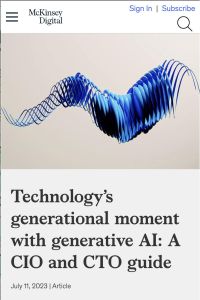Acesse a sua conta getAbstract para obter o resumo!

Acesse a sua conta getAbstract para obter o resumo!
Aamer Baig, Sven Blumberg, Eva Li, Douglas Merrill, Aditya Pradhan, Megha Sinha, Alexander Sukharevsky and Stephen Xu
Technology’s generational moment with generative AI
A CIO and CTO guide
McKinsey, 2023
Sobre o que é?
Follow these top tips to reap the full benefits of integrating generative AI into your business.
Recommendation
Generative AI – artificial intelligence that can create new content – has become a trendy buzzword in the business world, promising enormous value gains and competitive opportunities. Yet, like many technology trends before it, generative AI’s effectiveness depends on many factors – technical capability, talent management, risk mitigation and ethical considerations. This timely article by a group of McKinsey specialists provides CTOs and CIOs with nine actions that will help their businesses realize the full potential of generative AI.
Summary
About the Authors
Written for McKinsey Digital, this article is a collaboration by Aamer Baig, Sven Blumberg and Alexander Sukharevsky, who are all senior partners at McKinsey; Eva Li, who is a consultant for McKinsey; Megha Sinha and Douglas Merrill, who are partners at McKinsey; and Aditya Pradhan and Stephen Xu, who are associate partners.

















Comment on this summary